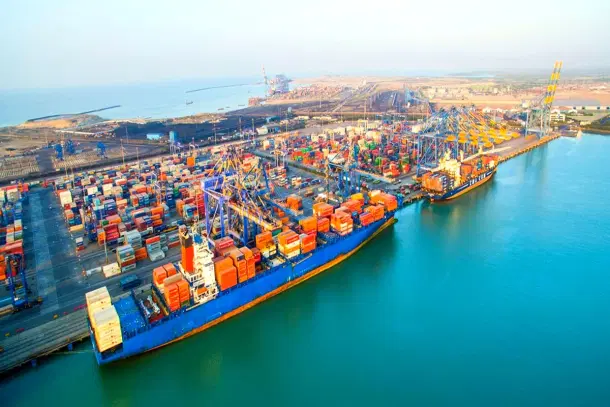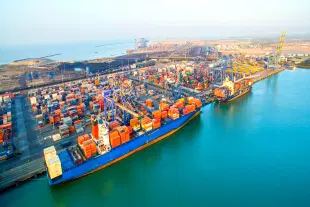Infrastructure
Can Adani's Entry Into Shipbuilding Propel India Into The Ranks Of The World's Top Shipbuilding Nations?
V Bhagya Subhashini
Jul 10, 2024, 05:27 PM | Updated Jul 11, 2024, 11:41 AM IST
Save & read from anywhere!
Bookmark stories for easy access on any device or the Swarajya app.


India's ambition to become a top-10 shipbuilding nation by 2030 and a top-five nation by 2047 is set to advance with Gautam Adani’s entry into the shipbuilding sector at Mundra Port.
This move aligns with both the Maritime India Vision (MIV) 2030 and the Maritime Amrit Kaal Vision 2047, which aim to establish India as a global economic superpower with a strong maritime sector.
The MIV 2030 is a comprehensive plan to transform India’s maritime sector, emphasising self-reliance. This vision is not merely about enhancing port infrastructure but also about capturing a significant share of the global shipbuilding market, a field where India currently lags behind.
To achieve MIV 2030 and Amrit Kaal Vision targets, the annual output of Indian shipyards needs to increase from 0.072 million gross tonnage (GT) to 0.33 million GT by 2030 and further to 11.31 million GT per year by 2047, according to KPMG.
India's shipbuilding industry holds immense strategic and economic importance. With high growth potential, it can create numerous job opportunities and contribute significantly to the gross domestic product (GDP).
The sector’s indirect benefits, spanning industries like steel, engineering equipment, and port infrastructure, further amplify its significance.
The Global Context: Opportunities And Challenges
Globally, the shipbuilding industry is dominated by South Korea, China, and Japan, which together hold over 90 per cent of the market share.
In contrast, India’s share is a mere 0.05 per cent, with Indian-owned and flagged ships accounting for only 5 per cent of its overseas cargo needs. This stark disparity underscores the need for a concerted effort to enhance India’s shipbuilding capabilities.
India's shipbuilding industry, despite its 32 shipyards and extensive coastline, struggles with competitiveness due to inadequate policy support, limited private participation, and firm-level inefficiencies.
On the other hand, global leaders like Japan, South Korea and China have thrived with substantial government support, foreign investments, and robust R&D initiatives. Japan and South Korea received significant subsidies and tax benefits in the past, while China continues to use direct aid and tax subsidies for growth.
However, shipyards in countries such as China, South Korea and Japan are fully booked until 2028, as reported by the Economic Times. This situation is forcing global fleet owners to consider alternatives, making it likely to view India as a potential manufacturing site for new vessels.
The demand for green ships to meet global decarbonisation goals also presents another significant opportunity. It is estimated that over 50,000 new vessels will be needed in the next 30 years to replace existing fleets.
This demand opens a lucrative market for India’s shipbuilding industry, which could potentially reach a worth of $62 billion by 2047, with ancillary industries contributing an additional $37 billion and creating around 12 million jobs.
But, India's support measures have mainly favoured the public sector, hindering broader industry benefits. The country also faces challenges attracting foreign investments due to regulatory hurdles.
Indian shipyards also currently face a cost disadvantage of up to 35 per cent compared to foreign shipyards. Despite government subsidies, this remains a significant barrier to competitiveness.
In this regard, Adani’s entry could catalyse a shift in the industry.
How Adani's foray can improve the competitiveness of Indian shipyards?
Adani’s venture into shipbuilding at Mundra Port is part of a Rs 45,000 crore expansion plan, which recently received environmental and coastal regulation zone clearance.
This strategic location, coupled with Adani’s established presence, provides a significant advantage. Unlike new entrants who face lengthy land acquisition and clearance processes, Adani can quickly enter the shipbuilding market, leveraging existing infrastructure and approvals.
The Special Economic Zone (SEZ) status of Mundra Port mitigates financial and tax challenges, making it easier to compete with established global shipyards. This strategic entry is expected to enhance India’s shipbuilding capacity and reputation, aligning with the Maritime India Vision 2030.
By leveraging economies of scale and the strategic advantages of Mundra Port, Adani’s initiative could reduce costs and improve the competitiveness of Indian shipyards.
Furthermore, to enhance competitiveness, India needs greater investment in skill development, R&D, and supportive regulations, similar to strategies adopted by Japan and South Korea.
In conclusion, Adani’s entry has the potential to propel India into the ranks of the top shipbuilding nations, realising the Maritime India Vision 2030 and paving the way for a prosperous maritime future.
V Bhagya Subhashini is a staff writer at Swarajya. She tracks infrastructure developments.




